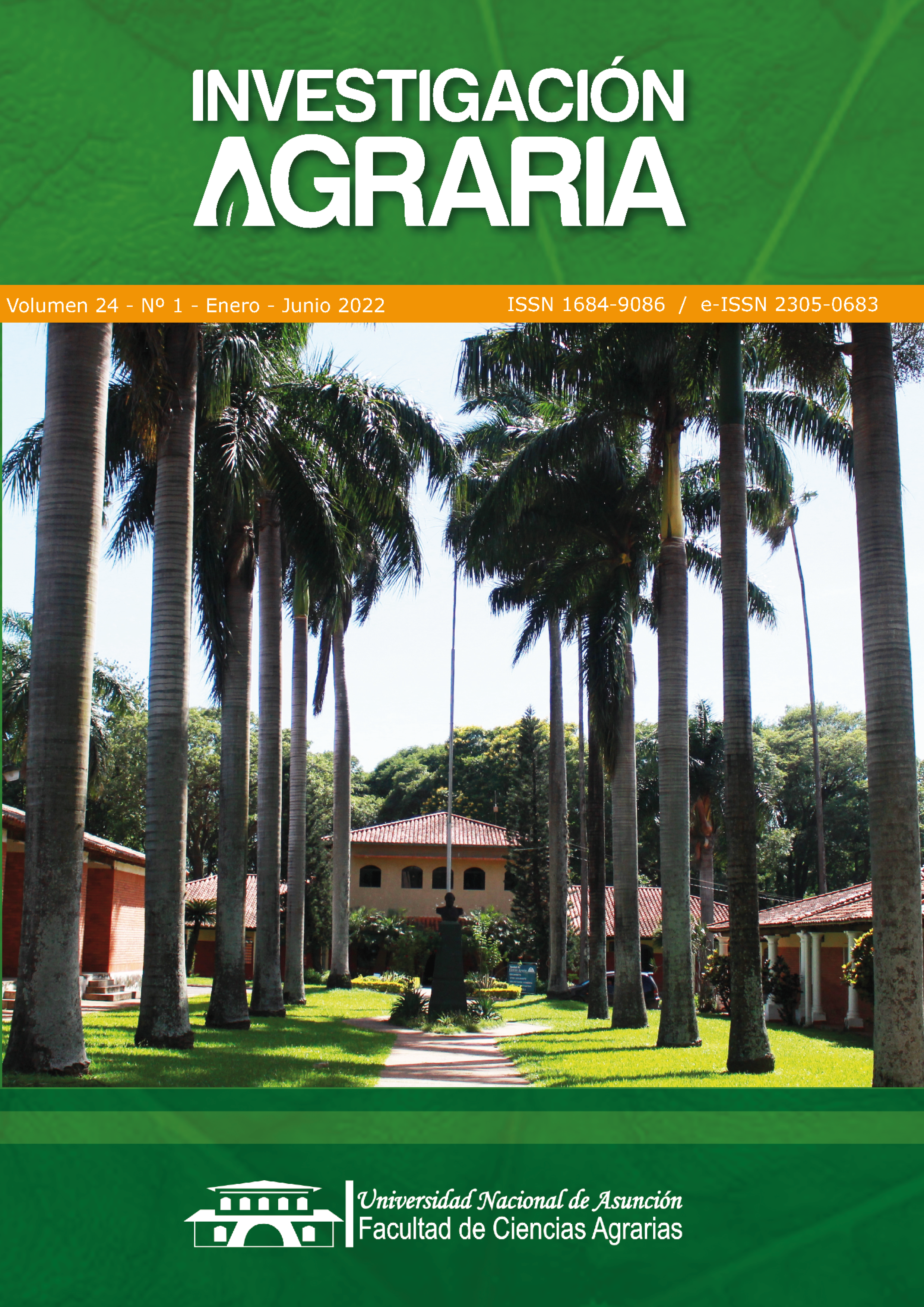Provisioning of the ecosystem service “total nitrogen retention” and its variation under changing land use and coverage in the Jejui Guazú river basin, Paraguay
DOI:
https://doi.org/10.18004/investig.agrar.2022.junio.2401704Keywords:
ecosystem services, total nitrogen, land use land cover, geographic information systemAbstract
One of the most important direct drivers affecting ecosystem services (ES) and their provision has been land use and land cover (LULC) change. The absence of information on how these factors affect ecosystem services provision can lead to their deterioration or unsustainable use. This research was carried out in the Jejui Guazú river watershed, in the Eastern Region of Paraguay, in order to describe the variation of the ecosystem service of total nitrogen (TN) retention and under forested area reduction, considering the ones without legal protection using the InVEST model and Geographic Information System’s software For this purpose, the land use and land cover of the year 2017 (where eight classes were identified), a digital elevation model, the annual average rainfall for the same year and sub-basin limits were generated. The results highlight the fundamental role of natural areas, both forests and wetlands, for the maintenance of the nutrient retention service. Especially, wetlands which present the highest percentage of TN retention, where watersheds covered by wetlands got 90.94 and 91.10% of retention; and the smallest decrease in its retention capacity with the change in the landscape configuration, decreasing only by 1.53%.Downloads
Metrics
References
Bastian, O., Grunewald, K. & Syrbe, R. (2012). Space and time aspects of ecosystem services, using the example of the EU Water Framework Directive. Disponible en https://doi.org/10.1080/21513732.2011.631941
Chalazas, T., Tzoraki, O., Cooper, D. M., Efstratiou, M. A. & Bakopoulos, V. (2017). Ecosystem service evaluation of streams for nutrient and bacteria purification in a grazed watershed. Fresenius Environmental Bulletin, 26, 7849-7859. Disponible en https://www.researchgate.net/publication/321747575_Ecosystem_service_evaluation _of_streams_for_nutrient_and_bacteria_purification_in_a_grazed_watershed
Crossman, N. V., Burkhard, B., Nedkov, S., Willemen, L., Petz, K., Palomo, I., Drakou, E., Martıín-López, B., McPhearson, T., Boyanova, K., Alkemade, R., Egoh, B. & Dunbar, M. B. & Maes, J. (2013). A blueprint for mapping and modelling ecosystem services. Disponible en: https://pdfs.semanticscholar.org/912e/dfe9c51cbd4ae7e369f71b0cd8b9a36ed250.pdf
Da Ponte, E., Mack, B., Wohlfart, B., Rodas, O., Fleckenstein, M., Oppelt, N., Dech, S. & Kuenze, C. (2017). Assessing Forest Cover Dynamics and Forest Perception in the Atlantic Forest of Paraguay, Combining Remote Sensing and Household Level Data. Disponible en https://www.mdpi.com/1999-4907/8/10/389/htm
De la Sancha, N., Boyle, S. & McIntyre, N. (2019). Identifying structural connectivity priorities in eastern Paraguay’s fragmented Atlantic Forest. Scientific reports,11. Disponible en: https://www.nature.com/articles/s41598-021-95516-3.pdf
Facultad de Ciencias Agrarias y Forestry and Forest Products Research Institute (Japón). (2013). Mapa de Cobertura de la Tierra Paraguay, 2011. Proyecto “Desarrollo de Metodologías de Monitoreo de Carbono almacenado en los Bosques” para la REDD+ en el Paraguay. San Lorenzo. 30 p.
Galluppi-Selich, T., Villalba, J., Salas-Dueñas D. A. & Rodríguez L. (2019). Análisis de la función ecosistémica “protección de acuíferos por cobertura vegetal” en la Reserva de Biósfera del Bosque Mbaracayú. Disponible en: http://sociedadcientifica.org.py/ojs/index.php/rscpy/article/view/59
Guarín, A. & Hotz, H. (2015). El análisis de servicios ecosistémicos forestales como herramienta para la formulación de políticas nacionales en el Perú. SERFOR - Servicio Nacional Forestal y de Fauna Silvestre. Disponible en http://repositorio.serfor.gob.pe/bitstream/SERFOR/264/1/SERFOR.%202015.%20El%20an%C3%A1lisis%20de%20SE%20forestales%20como%20herramienta.pdf
Imbach, P., Robalino, J., Zamora, J., Brenes, C., Sandoval, C., Pacay, E., Cifuentes-Jara, M. & Labbate, G. (2016). Escenarios de deforestación futura en Paraguay. Asunción, Paraguay: FAO/PNUD/PNUMA, 16 p.
IPBES. (2019). Global assessment report of the Intergovernmental Science-Policy Platform on Biodiversity and Ecosystem Services. doi:10.5281/zenodo.3553579
Naidoo, R. & Ricketts, T.H. (2006). Mapping the Economic Costs and Benefits of Conservation. Disponible en https://journals.plos.org/plosbiology/article?id=10.1371/journal.pbio.0040360
Ojeda, J., Amarilla, S. & Villalba, J. (2019). Stock de carbono y propiedades del suelo para dos coberturas forestales en la ecorregión del Bosque Atlántico del Alto Paraná. Congreso Paraguayo de Ciencia del Suelo. Sociedad Paraguaya de Ciencia del Suelo. San Lorenzo, Paraguay: SOPACIS, 81-86 pp.
Saunders, D. & Kalff, J. (2001). Nitrogen retention in wetlands, lakes and rivers. Hydrobiologia, Vol. 443. Disponible en https://booksc.xyz/dl/11171755/ac04f5
Sharp, R., Tallis, H. T., Ricketts, T., Guerry, A. D., Wood, S., Chaplin-Kramer, R., Nelson, E., Ennaanay, D., Wolny, S., Olwero, N., Vigerstol, K., Pennington, D., Mendoza, G., Aukema, J., Foster, J., Forrest, J., Cameron, D., Arkema, K., Lonsdorf, E., Kennedy, C., Verutes, G., Kim, C.K., Guannel, G., Papenfus, M., Toft, J., Marsik, M., Bernhardt, J., Griffin, R., Glowinski, K., Chaumont, N., Perelman, A., Lacayo, M., Mandle, L., Hamel, P., Vogl, A.L., Rogers, L., Bierbower, W., Denu, D. & Douglass, J. (2018). InVEST User’s Guide. Disponible en http://data.naturalcapitalproject.org/nightly-build/invest-usersguide/InVEST_+VERSION+_Documentation.pdf
Published
How to Cite
Issue
Section
License
Copyright (c) 2022 Andrea Carolina Parra Ruiz Díaz, Lucía-Janet Villalba-Marín, Stella-Mary Amarilla-Rodríguez

This work is licensed under a Creative Commons Attribution 4.0 International License.
All content in this journal is under Creative Commons Attribution License.









 All content in this journal is under
All content in this journal is under 